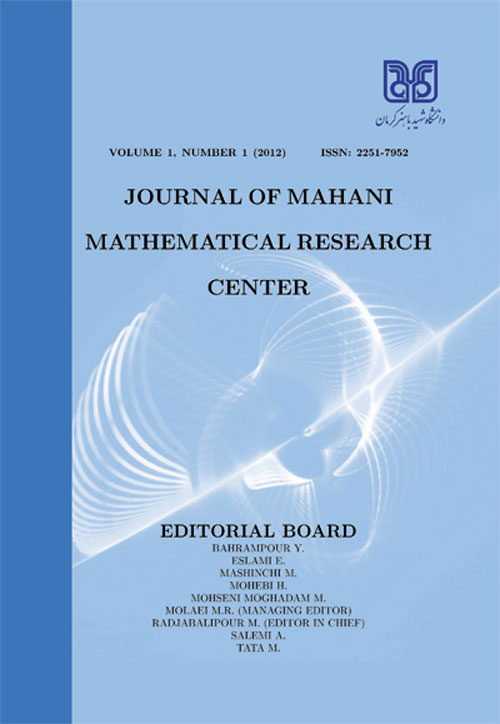فهرست مطالب

Journal of Mahani Mathematical Research
Volume:2 Issue: 2, Autumn 2013
- تاریخ انتشار: 1392/08/10
- تعداد عناوین: 6
-
Pages 1-15
We give further results for Perron-Frobenius theory on the numerical range of real matrices and some other results generalized from nonnegative matrices to real matrices. We indicate two techniques for establishing the main theorem of Perron and Frobenius on the numerical range. In the rst method, we use a corresponding version of Wielandt's lemma. The second technique involves graph theory.
Keywords: sign, real numerical radius, real spectral radius, Perron, Frobenius theory, signature matrices, numerical range -
Pages 17-28
In this paper by use of mathematical modeling of an observer [14, 15] the notion of relative information functional for relative dynamical systems on compact metric spaces is presented. We extract the information function of an ergodic dynamical system (X,T) from the relative information of T from the view point of observer χX, where X denotes the base space of the system. We also generalize the invariance of the information function of a dynamical system , under topological isomorphism, to the relative information functional.
Keywords: Information function, relative dynamical system, relative generator, relative measure, relative information functional -
Pages 29-37
There are many situations for statistical process in which we have both random and vague information. When uncertainty is due to fuzziness of information, fuzzy statistical control charts play an important role in the monitoring process, because they simultaneously deal with both kinds of uncertainty. Dealing with fuzzy characteristics using classical methods may cause the loss of information and in uence in process deciding making. In this paper, we proposed a decision-making process based on fuzzy rejection regions and fuzzy statistical tests for crisp observation. With both methods, we de ne the degree of depen- dence to acceptance region for decision in the fuzzy regions and process fuzzy. A numeric example illustrates the performance of the method and interprets the results.
Keywords: fuzzy hypotheses testing, fuzzy rejection region, hybrid numbers -
Pages 39-60
In this paper, we use the de nition of fuzzy normed spaces given by Bag and Samanta and the behaviors of solutions of the additive functional equation are described. The Hyers-Ulam stability problem of this equation is discussed and theorems concerning the Hyers-Ulam-Rassias stability of the equation are proved on fuzzy normed linear space.
Keywords: Fuzzy norm, Fuzzy normed linear space, Functional equation -
Pages 61-72
The parallel systems are special important types of coherent structures and have many applications in various areas.
In this paper we consider a two-exchangeable-component parallel system for the Generalized Farlie-Gumbel-Morgenstern (Generalized FGM) distribution. We study the reliability properties of the residual lifetime of the system under the condition that both components of the system are operating at time t, and obtain an explicit expression for the mean residual lifetime (MRL) for such system. The asymptotic behavior of the proposed MRL function of the system is also investigated when the exchangeable lifetimes of components have a Generalized FGM bivariate exponential. Finally, we present some results for the Kendalls Tau correlation coefficient of Generalized FGM bivariate copula.Keywords: mean residual lifetime, copula, exponential distribution, reliability -
Pages 73-87
Several practical problems of hypotheses testing can be under a general linear model analysis of variance which would be examined. In analysis of variance, when the response random variable Y , has linear relationship with several random variables X, another important model as analysis of covariance can be used. In this paper, assuming that Y is fuzzy and using DLR metric, a method for testing the linear hypothesis has been proposed based on fuzzy techniques. In fact, in this method a set of con dence intervals has been used for creating fuzzy test statistic and fuzzy critical values. In addition, the proposed method has been mentioned for the reforming of the hypothesis testing when there is an uncertaity in accepting or rejecting hypotheses. Finally, by presenting two examples this method is illustrated. The result are illustrated by the means of some case studies.
Keywords: Analysis of covariance, Buckley's method, Confidence interval, DLR metric, Fuzzy test statistic

